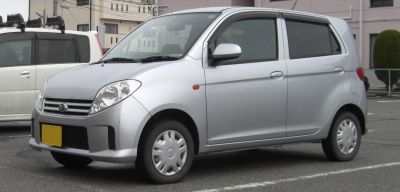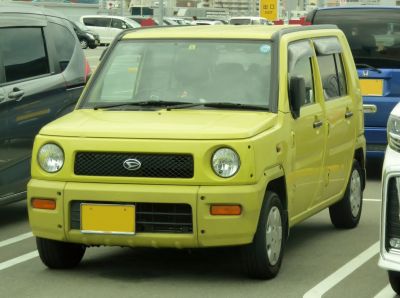 1999 Suzuki Kei (HN) Dimensions, Size & Specs
1999 Suzuki Kei (HN) Dimensions, Size & SpecsMeasurements of the 1999 Suzuki Kei, engineered for optimal performance and comfort
| Dimensions | |
|---|---|
| Length: | 3395 mm133.7 in11.1 ft |
| Width: | 1475 mm58.1 in4.8 ft |
| Height: | 1530-1545 mm60.2-60.8 in5.0-5.1 ft |
| Weight Specifications | |
| Curb Weight: | 740-770 kg1631-1698 lbs |
| Maximal permitted Weight: | 960-990 kg2116-2183 lbs |
| Tire Specifications | |
| Rims Sizes: |
|
| Tire Sizes: |
|
The Suzuki Kei (HN) is a compact hatchback produced from 1998 to 2009, designed primarily for the Japanese kei car segment. This generation offers an excellent balance of small exterior dimensions and lightweight construction, making it an ideal urban car. The vehicle measures 3395 mm (133.7 inches) in length and 1475 mm (58.1 inches) in width, placing it comfortably within the kei car size regulations. Its height varies slightly between 1530 mm (60.2 inches) and 1545 mm (60.8 inches), providing a tall, spacious interior for passengers despite its compact footprint. Weighing between 740 kg (1631 lbs) and 770 kg (1698 lbs) in curb weight, the Suzuki Kei is nimble and efficient, offering easy maneuverability and fuel economy. The maximum loaded weight ranges from 960 kg (2116 lbs) to 990 kg (2183 lbs), supporting a modest payload for day-to-day use. The car rides on rims available in 13-inch and 15-inch sizes, paired with tires sized either 155/80 R13, 165/60 R15, or 155/80 R13 S, balancing ride comfort and road grip. Overall, the Suzuki Kei (HN) generation represents a practical and space-efficient city car with a lightweight design, tailored for efficient urban driving and easy parking, making it a great option for drivers seeking convenience without sacrificing functionality.
Discover the standout features that make the 1999 Suzuki Kei a leader in its class
Have a question? Please check our knowledgebase first.
The Suzuki Kei (HN) generation produced from 1998 to 2009 has a compact dimension suited for urban driving and kei car regulations. The length measures 3395 mm (approximately 133.5 inches), ensuring the car stays within the kei car length restrictions in Japan. The width is 1475 mm (around 58.1 inches), making it narrow enough for tight city streets and parking. Height varies from 1530 mm to 1545 mm (about 60.2 to 60.8 inches), providing a somewhat tall profile for better headroom and improved visibility. These dimensions contribute to the vehicle's maneuverability and compliance with kei car standards, which aim to optimize size for urban practicality and low ownership costs.
The curb weight of the Suzuki Kei (HN) ranges between 740 kg to 770 kg (approximately 1631 to 1698 pounds), which refers to the weight of the vehicle with standard equipment, fluids, and a full tank of fuel but without passengers or cargo. The maximum permissible weight, which includes the vehicle's curb weight, passengers, cargo, and any additional equipment, ranges from 960 kg to 990 kg (about 2116 to 2183 pounds). This relatively light weight contributes to the car's fuel efficiency and nimble handling, characteristics prized in kei cars focused on economical city transportation and easy maneuvering.
Yes, the Suzuki Kei (HN) is designed to fit easily into a standard residential garage due to its compact size. With a length of 3395 mm (133.5 inches) and a width of 1475 mm (58.1 inches), it is significantly smaller than most typical passenger vehicles, which means it occupies less space in the garage. Most residential garages in many countries have an internal width of about 2400 mm to 3000 mm (94.5 to 118 inches) and a length of 5400 mm or more (212.6 inches), comfortably accommodating the Suzuki Kei with ample space for doors to open and for easier movement around the vehicle. Its moderate height ranging up to 1545 mm (60.8 inches) poses no challenge for standard garage door clearances.
The Suzuki Kei (HN) offers rim sizes of 13 inches and 15 inches, with corresponding tire sizes of 155/80 R13, 165/60 R15, and 155/80 R13 S. Smaller 13-inch rims with higher profile tires (155/80 R13) provide a softer ride by better absorbing road imperfections, which is beneficial for comfort on urban and uneven surfaces. The 15-inch rims with lower profile tires (165/60 R15) offer a sportier appearance and potentially more responsive handling due to reduced tire sidewall flex, but this can result in a firmer ride. The tire widths are narrow by modern standards, which helps in maintaining agility and good fuel consumption. This combination of sizes and types allows owners to balance between comfort and sportiness depending on their preference and road conditions.
The Suzuki Kei's height range of 1530 mm to 1545 mm (about 60.2 inches to 60.8 inches) contributes positively to its interior cabin space, especially in terms of headroom. This relatively tall stature for a kei car offers a comfortable seating position with ample vertical space for the driver and passengers, enhancing comfort during longer trips. The elevated height also improves driver visibility over other vehicles and city traffic, a crucial advantage in tight urban environments. However, the slightly increased height compared to some smaller hatchbacks might marginally affect aerodynamic efficiency, but this is typically negligible given the overall design focus on practicality and ease of use.
The Suzuki Kei (HN) generation introduced in 1998 evolved significantly from its predecessor in terms of dimensions and design. While maintaining compliance with Japan's kei car regulations, which restrict vehicle size, the HN generation measured 3395 mm in length and 1475 mm in width, dimensions that may have been either slightly refined or optimized for better interior space utilization and improved safety features. The height also was adjusted to between 1530 mm and 1545 mm, providing better headroom. In terms of design, the HN series likely included modernized aesthetics with more contemporary lines, improved aerodynamics, and updated mechanical components to enhance fuel efficiency and driving comfort. Overall, the HN generation balanced compactness with practicality better than earlier models, accommodating changes in consumer demands and regulatory requirements.
Dimensionally, the Suzuki Kei (HN) fits well within the typical kei car segment standards of the late 1990s and 2000s. With a length of 3395 mm and width of 1475 mm, it aligns closely with competitors like the Daihatsu Move, Honda Life, and Mitsubishi Minica, which share similar size restrictions to maximize interior space while staying compact externally. Weight-wise, the Kei's range from 740 kg to 770 kg is competitive, supporting lightweight construction aimed at fuel efficiency. Performance varies across kei cars depending on engine tuning, but the Suzuki Kei emphasizes agility and economy over outright power. Its compact dimensions favor maneuverability in congested urban settings, mirroring the strengths of its competitors. In terms of interior room and comfort, the taller height range enhances passenger comfort relative to some rivals, ensuring the Suzuki Kei remains a popular choice within the segment.
The Suzuki Kei (HN) offers multiple tire and rim configurations, including 13-inch rims paired with 155/80 R13 tires and 15-inch rims with 165/60 R15 tires. The 13-inch wheels with higher profile tires typically improve ride comfort by absorbing road bumps and irregularities, which is ideal for city driving and rough urban roads. Conversely, the larger 15-inch rims with lower profile tires provide improved cornering response and a sportier feel due to reduced tire flex, but with a trade-off in ride softness. Both setups are designed around narrow tire widths, which enhance fuel economy and help maintain nimble handling—key traits for a kei car focused on economical urban transportation without compromising agility.
The Suzuki Kei (HN) has a maximum permissible weight ranging between 960 kg to 990 kg (about 2116 to 2183 pounds). This maximum weight includes the vehicle's curb weight, passengers, cargo, and any additional equipment. Considering its curb weight is around 740 to 770 kg (1631 to 1698 pounds), this means the car can carry a payload of approximately 190 to 250 kg (419 to 551 pounds). This capacity is sufficient for a typical small family or couple carrying groceries and light luggage, aligning well with the kei car's role as an economical city vehicle. However, it is essential not to exceed this limit to ensure safety, handling stability, and maintain fuel efficiency. Load capacity within these limits makes the Suzuki Kei a practical choice for urban daily driving and light utility tasks.
Despite its compact exterior dimensions—3395 mm in length, 1475 mm in width, and up to 1545 mm in height—the Suzuki Kei (HN) offers an intelligently designed interior that maximizes passenger comfort and cargo space for a vehicle of its size. The relatively tall height improves headroom, and Suzuki’s efficient use of interior layout allows seating for four occupants with reasonable comfort for city trips. The hatchback design facilitates easy loading and unloading of cargo, with rear seats likely folding flat to expand luggage capacity. The vehicle’s narrow width is balanced by its clever packaging, ensuring that the cabin feels less cramped than one might expect. Such space utilization is a hallmark of kei cars, making the Suzuki Kei a popular option for urban drivers who need efficient use of space without excess bulk.
Discover similar sized cars.

| Production: | 2001-2003 |
|---|---|
| Model Year: | 2001 |
| Length: | 3395 mm133.7 in |
| Width: | 1475 mm58.1 in |
| Height: | 1550 mm61.0 in |

| Production: | 2002-2004 |
|---|---|
| Model Year: | 2000 |
| Length: | 3395 mm133.7 in |
| Width: | 1475 mm58.1 in |
| Height: | 1550 mm61.0 in |

| Production: | 1998-2006 |
|---|---|
| Model Year: | 1999 |
| Length: | 3355-3395 mm132.1-133.7 in |
| Width: | 1475 mm58.1 in |
| Height: | 1530-1550 mm60.2-61.0 in |

| Production: | 2020-present |
|---|---|
| Model Year: | 2020 |
| Length: | 3395 mm133.7 in |
| Width: | 1475 mm58.1 in |
| Height: | 1545-1570 mm60.8-61.8 in |
